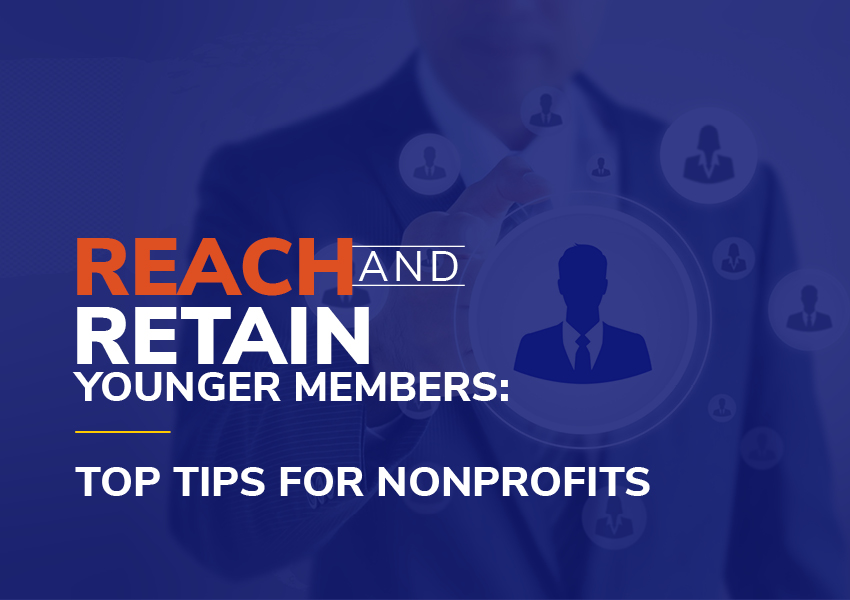Reach and Retain Younger Members: 3 Tips for Nonprofits

For nonprofits, recruiting Millennial and Generation Z members can lead to a lifetime of support and engagement from these passionate individuals. Since these generations look for ways to channel their passion for activism, human rights, and volunteering, your nonprofit can help them carry out the change they seek.
While organizations may tend to overlook these younger prospects when promoting their membership programs, acquiring their support can go a long way toward securing a nonprofit’s long-term success.
To resonate with younger generations, inspire them to become members, and grow into regular contributors, you’ll need to adopt innovative strategies that resonate with their values and interests.
In this guide, we’ll discuss three impactful tips to reach younger members and keep them engaged with your nonprofit.
1. Leverage technology
Modern technology has transformed the way people engage with one another. As digital natives, technology is an essential resource for Millennials and Gen Zers to stay connected with and up to date about the people and causes they care about.
Nonprofits can reach younger members by leaning into the online tools at their disposal and fine-tuning their digital presence.
To harness technology and facilitate more online experiences with younger prospective members, consider these strategies:
- Include QR codes in your direct mail and flyers: Younger individuals are more likely to donate when the payment process is fast and familiar. Streamline the donation process with easy-to-scan QR codes in your direct mail and flyers that take them directly to your donation page.
- Set up text messaging and text-to-give: 360MatchPro reports that 98% of Millennials own a smartphone and 37% of them have used it to donate. Send texts to your younger audience letting them know how they can support your nonprofit. Also, set up a text-to-give program to let your younger audience easily contribute to your cause right from their phones.
- Create a donation button: Make the donation process stand out on your website and social media channels by setting up a donate online button. This button can be added to your website’s top navigation and on social media platforms like Instagram.
- Automate membership renewals: Add an automation option for your membership renewals to maintain more members. Not only will this save your members time from having to renew their own memberships, but it can also make your supporters more likely to continue supporting your nonprofit.
Overall, ensure that your membership website is informational, simple to navigate, and links to your social networks so younger supporters can get involved with your digital community. Also, make sure that your website looks and works great on both desktop and mobile devices.
2. Create engaging online content
According to DataReportal, people spend an average of 6 hours and 37 minutes using the internet every day. This, combined with the popularity of social media, makes it all the more important for nonprofits to create interesting online content that motivates younger demographics to get involved.
Not only is social media a great place to demonstrate the work your nonprofit does, but it’s also an effective channel for resonating with younger generations. Engaging young, prospective members on social media is important because 59% of Gen Zers have been inspired to donate because of a message or image they saw on the platform.
To leave a lasting impression, nonprofits should feature compelling imagery and provide details about the impact they make which can inspire young people to become members. To resonate in the hearts of Millennials and Gen Zers, consider creating the following content across your social channels:
- Images and videos: For these visually oriented generations, you can demonstrate your nonprofit’s impact through images and videos. You can post images of your leadership team with a caption explaining why the nonprofit was created and a video of your team helping the community you support.
- Live streams: Bring the excitement of live events to potential supporters, no matter where they are, with live streams. From broadcasting conferences to sharing educational materials and Q&A sessions with your leadership, these events allow for authentic engagement opportunities with Millennials and Gen Zers.
- Collaborations: By teaming up with influencers, you can spread the word about your nonprofit and encourage their audience to get involved. Be sure to collaborate with influencers who align with your values, feel authentic, and have a strong following with younger people. Together, you can create sponsored posts about your nonprofit, organize social media takeovers, and hold Q&A sessions.
While crafting this content, leverage storytelling tactics. Storytelling helps you create emotional connections with your audience while demonstrating your nonprofit’s impact.
Ensure that your content explains why your nonprofit exists, the work you do, and who you support. Then, show how contributions create meaningful change. This will illustrate to potential members how they can make a difference.
Let’s look at charity: water as an example. This nonprofit is dedicated to providing everyone in the world with clean and safe water. On their Instagram, they share pictures of the people they provide water to, explain the projects they led, and detail how donations are used. Not only does charity: water demonstrate their contributors’ impact, but they also let people know how they can get involved.
3. Offer multiple ways to contribute
While younger members may not have as much financial capacity as older generations in your nonprofit, they can still provide tremendous support. By offering multiple ways Millennials and Gen Zers can contribute, they’ll be more likely to stay involved with your nonprofit once their capacity to give financially grows.
You can get younger members contributing towards your cause by leveraging their skills and drive for change by:
- Organizing volunteering programs: Develop volunteer programs that everyone in your nonprofit can contribute to like setting up conference spaces, welcoming guests at events, and fine-tuning your membership website.
- Requesting matching gifts: Your Millennial and Gen Z members may work at companies with matching gift programs. That means when your member donates to a nonprofit, their company will also make a contribution. Ask your members if their jobs offer this program so they can maximize their donations.
- Having younger members attend relevant events: By hosting engaging events geared to younger members’ tastes, like fun runs and sports tournaments, they’ll be excited to take part. To attract even more attendees, you can offer giveaways and serve free food.
- Letting younger members spread the word: Your younger members are tapped into social media and know how to reach the audiences that you want to speak to. Let these members use their digital savvy to guide your social media strategy.
- Creating leadership opportunities: Ask younger members to become a committee or board member for your nonprofit. Offering this role lets your young members share their ideas while showing other Millennials and Gen Zers that you value their perspective.
Just like with your older members, be sure to thank Millennials and Gen Zers for their support with personalized messages. Making them feel like a part of your organization’s overall impact will keep them motivated to continue supporting your mission year after year.
Millennials and Gen Zers are a critical segment for the sustainability of your nonprofit. These younger demographics will channel their drive for change within your nonprofit, strengthening your cause with their passion and technological savvy. As they grow, they’ll be on track to make even more impact down the line with financial contributions.
Additionally, nonprofits can determine how to better reach and retain younger members by sending surveys. You’ll get direct feedback about their experiences with the organization, see where you can improve, and make them feel included in the decision-making process.


